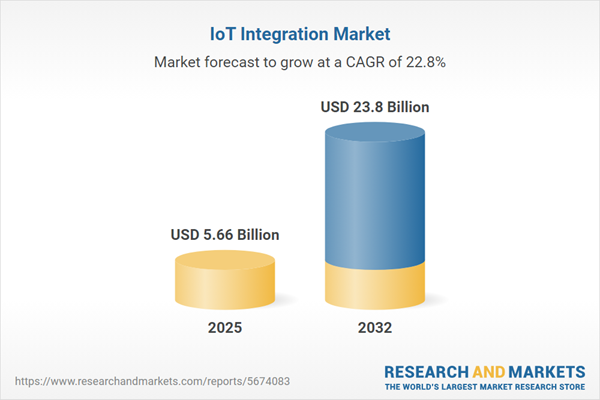Speak directly to the analyst to clarify any post sales queries you may have.
The IoT Integration Market unlocks seamless technology unification, enabling organizations to optimize data flows and strengthen operational security as they pursue digital transformation initiatives. Senior executives prioritizing agile, modern infrastructure are leveraging IoT integration to drive compliance and support business modernization across all departments.
Market Snapshot: Growth & Trends in the IoT Integration Market
The IoT Integration Market is advancing at a rapid pace, with robust growth recorded from USD 4.60 billion in 2024 to USD 5.66 billion in 2025, and a projected expansion to USD 23.80 billion by 2032, achieving a compound annual growth rate of 22.78%.
This momentum is driven by increasing demand for interoperable and secure solutions that offer high scalability and prompt responsiveness. Evolving system architectures facilitate seamless connectivity between established assets and next-generation technologies, while modern connectivity protocols enable real-time visibility throughout business operations. Continuous improvements in IoT hardware, tailored software, and analytics frameworks are driving greater efficiency, positioning organizations to respond more effectively to changing operational needs and industry pressures.Scope & Segmentation in the IoT Integration Market
This report supports senior decision-makers with comprehensive segmentation, offering strategic insights into how organizations can plan technology investments and risk management across diverse contexts and geographies:
- Component Type: Hardware elements—modules, gateways, sensors, actuators, and processors—lay the foundation for integration, while managed services and advanced software address analytics, security, and data synchronization priorities.
- Application: Core deployment areas include asset tracking, predictive maintenance, fleet management, smart metering, video analytics, and remote monitoring. These applications enable timely, data-driven decisions and automation initiatives organization-wide.
- End Use Industry: Industries such as energy, oil and gas, renewables, automotive, electronics, healthcare, smart cities, retail, pharmaceuticals, transportation, power, and food and beverage each require tailored integration strategies based on sector-specific compliance and modernization burdens.
- Deployment Model: Public, private, hybrid cloud, and on-premise models allow flexible adaptation of risk management and help align integration with regulatory standards.
- Connectivity Technology: Utilization of both wired technologies (Ethernet, Modbus, Profinet) and wireless options (Bluetooth, 5G, LTE, LPWAN, Wi-Fi) facilitates robust, adaptable integration architectures in both centralized and distributed operations.
- Organization Size: Scalable solutions accommodate the distinct needs of large enterprises and small to mid-sized businesses to propel broad-based digital transformation.
- Geographical Coverage: The research spans the Americas, Europe, Middle East & Africa, and Asia-Pacific, illustrating varying regional approaches to digital integration and regulatory influence.
- Company Analysis: Industry leaders such as Microsoft, Amazon, IBM, SAP SE, Accenture, PTC, Oracle, Cisco, Siemens, and General Electric contribute critical expertise, shaping the advancement of global IoT integration standards.
Key Takeaways for Senior Decision-Makers
- Integrating operational technology and cloud analytics delivers actionable insights, enhancing productivity and encouraging organization-wide data-driven enhancements.
- The adoption of edge computing and machine learning extends intelligent decision-making to the network edge, supporting real-time local adaptation to operational changes.
- Strong data governance combined with advanced cybersecurity is essential to mitigate risk and achieve compliance within complex digital systems.
- Collaboration with telecom and specialty integration partners removes deployment barriers, accelerates solution rollout, and provides scalable expansion capabilities across multiple regions.
- Engagement with experts ensures that integration is tailored to distinct business and regulatory requirements specific to industry verticals.
- Flexible integration frameworks empower organizations to efficiently handle evolving operational needs and respond to ever-changing regulatory environments.
Tariff Impact: Navigating 2025 U.S. Tariffs on IoT Supply Chains
With impending U.S. tariffs on electronic components in 2025, organizations are reassessing supply chain strategies within the IoT integration market. Reinforcing supplier relationships, expanding manufacturing bases, and leveraging modular hardware technologies help secure operational continuity. Utilizing simulation and virtual prototyping tools also streamlines risk response and enhances agility amid regulatory changes.
Methodology & Data Sources
This analysis is based on extensive desk research, regular tracking of regulatory changes, and structured executive interviews. Subject matter expertise and the integration of private and public data sources underpin the reliability and executive relevance of the findings.
Why This Report Matters
- Informs strategic technology investment and IoT adoption decisions aligned with organizational objectives.
- Supports early identification of risks, enhances compliance frameworks, and enables the construction of resilient, scalable infrastructure.
- Facilitates optimal allocation of resources and highlights regional growth opportunities through in-depth market evaluation.
Conclusion
This report provides senior leaders with actionable guidance for secure, adaptive digital transformation, enabling organizations to meet dynamic market and compliance expectations with confidence.
Additional Product Information:
- Purchase of this report includes 1 year online access with quarterly updates.
- This report can be updated on request. Please contact our Customer Experience team using the Ask a Question widget on our website.
Table of Contents
3. Executive Summary
4. Market Overview
7. Cumulative Impact of Artificial Intelligence 2025
Companies Mentioned
The companies profiled in this IoT Integration market report include:- Microsoft Corporation
- Amazon.com, Inc.
- International Business Machines Corporation
- SAP SE
- Accenture plc
- PTC Inc.
- Oracle Corporation
- Cisco Systems, Inc.
- Siemens Aktiengesellschaft
- General Electric Company
Table Information
| Report Attribute | Details |
|---|---|
| No. of Pages | 192 |
| Published | October 2025 |
| Forecast Period | 2025 - 2032 |
| Estimated Market Value ( USD | $ 5.66 Billion |
| Forecasted Market Value ( USD | $ 23.8 Billion |
| Compound Annual Growth Rate | 22.7% |
| Regions Covered | Global |
| No. of Companies Mentioned | 11 |









